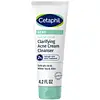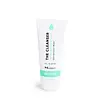What's inside
What's inside
 Key Ingredients
Key Ingredients

 Benefits
Benefits

 Concerns
Concerns

 Ingredients Side-by-side
Ingredients Side-by-side

Water
Skin ConditioningCocamidopropyl Betaine
CleansingDistearyl Phthalic Acid Amide
EmollientSodium Methyl Cocoyl Taurate
CleansingSodium Chloride
MaskingCetyl Alcohol
EmollientStearyl Alcohol
EmollientPEG-120 Methyl Glucose Dioleate
EmulsifyingPhenoxyethanol
PreservativeSodium Hydroxide
BufferingCaprylyl Glycol
EmollientEthylhexylglycerin
Skin ConditioningHexylene Glycol
EmulsifyingDisodium EDTA
Isopropyl Alcohol
SolventAloe Barbadensis Leaf Juice
Skin ConditioningButylene Glycol
HumectantCamellia Sinensis Leaf Extract
AntimicrobialWater, Cocamidopropyl Betaine, Distearyl Phthalic Acid Amide, Sodium Methyl Cocoyl Taurate, Sodium Chloride, Cetyl Alcohol, Stearyl Alcohol, PEG-120 Methyl Glucose Dioleate, Phenoxyethanol, Sodium Hydroxide, Caprylyl Glycol, Ethylhexylglycerin, Hexylene Glycol, Disodium EDTA, Isopropyl Alcohol, Aloe Barbadensis Leaf Juice, Butylene Glycol, Camellia Sinensis Leaf Extract
Water
Skin ConditioningSodium Methyl Cocoyl Taurate
CleansingSodium Coco-Sulfate
CleansingSodium Chloride
MaskingCocamidopropyl Betaine
CleansingSodium Cocoyl Glutamate
CleansingPhenoxyethanol
PreservativeBenzoic Acid
MaskingEthylhexylglycerin
Skin ConditioningGlycereth-2 Cocoate
EmulsifyingCitric Acid
BufferingCitrus Limon Fruit Oil
AstringentGuar Hydroxypropyltrimonium Chloride
Skin ConditioningPolysorbate 20
EmulsifyingBehentrimonium Chloride
PreservativeSorbitol
HumectantCaffeine
Skin ConditioningCamellia Sinensis Leaf Extract
AntimicrobialCucumis Sativus Fruit Extract
EmollientZingiber Officinale Root Extract
MaskingCarum Petroselinum Extract
Skin ConditioningActinidia Arguta Juice
EmollientSaururus Chinensis Extract
Skin ConditioningSpinacia Oleracea
Skin ConditioningPyrus Malus Fruit Extract
Skin ConditioningBrassica Oleracea Acephala Leaf Extract
HumectantWater, Sodium Methyl Cocoyl Taurate, Sodium Coco-Sulfate, Sodium Chloride, Cocamidopropyl Betaine, Sodium Cocoyl Glutamate, Phenoxyethanol, Benzoic Acid, Ethylhexylglycerin, Glycereth-2 Cocoate, Citric Acid, Citrus Limon Fruit Oil, Guar Hydroxypropyltrimonium Chloride, Polysorbate 20, Behentrimonium Chloride, Sorbitol, Caffeine, Camellia Sinensis Leaf Extract, Cucumis Sativus Fruit Extract, Zingiber Officinale Root Extract, Carum Petroselinum Extract, Actinidia Arguta Juice, Saururus Chinensis Extract, Spinacia Oleracea, Pyrus Malus Fruit Extract, Brassica Oleracea Acephala Leaf Extract
Ingredients Explained
These ingredients are found in both products.
Ingredients higher up in an ingredient list are typically present in a larger amount.
Camellia Sinensis Leaf Extract is derived from the leaves of the tea plant. Black tea, green tea, and oolong tea are all harvested from this plant.
This ingredient has many skin benefits:
This ingredient contains polyphenols, a strong antioxidant. Antioxidants help fight off molecules that damage skin cells.
On top of that, the antioxidants in green tea neutralize free-radicals from the sun. This gives the skin some extra UV protection, but should not replace sunscreen.
Many components of tea have anti-inflammatory properties.
Polyphenols and L-theanine help soothe the skin and reduce irritation. The caffeine in Camellia Sinensis Leaf Extract helps calm inflamed blood vessels.
Other compounds found in tea include: Vitamin Bs, linoleic acid, magnesium, calcium, iron, and zinc.
Research has shown both drinking Camellia Sinensis Leaf Tea and applying it to the skin can help boost skin elasticity and hydration. Studies also show using tea extract may reduce sebum, or oil, production.
Learn more about Camellia Sinensis Leaf ExtractCocamidopropyl Betaine is a fatty acid created by mixing similar compounds in coconut oil and dimethylaminopropylamine, a compound with two amino groups.
This ingredient is a surfactant and cleanser. It helps gather the dirt, pollutants, and other impurities in your skin to be washed away. It also helps thicken a product and make the texture more creamy.
Being created from coconut oil means Cocamidopropyl Betaine is hydrating for the skin.
While Cocamidopropyl Betaine was believed to be an allergen, a study from 2012 disproved this. It found two compounds in unpure Cocamidopropyl Betaine to be the irritants: aminoamide and 3-dimethylaminopropylamine. High-grade and pure Cocamidopropyl Betaine did not induce allergic reactions during this study.
Learn more about Cocamidopropyl BetaineEthylhexylglycerin (we can't pronounce this either) is commonly used as a preservative and skin softener. It is derived from glyceryl.
You might see Ethylhexylglycerin often paired with other preservatives such as phenoxyethanol. Ethylhexylglycerin has been found to increase the effectiveness of these other preservatives.
Phenoxyethanol is a preservative that has germicide, antimicrobial, and aromatic properties. Studies show that phenoxyethanol can prevent microbial growth. By itself, it has a scent that is similar to that of a rose.
It's often used in formulations along with Caprylyl Glycol to preserve the shelf life of products.
Chances are, you eat sodium chloride every day. Sodium Chloride is also known as table salt.
This ingredient has many purposes in skincare: thickener, emulsifier, and exfoliator.
You'll most likely find this ingredient in cleansers where it is used to create a gel-like texture. As an emulsifier, it also prevents ingredients from separating.
There is much debate on whether this ingredient is comedogenic. The short answer - comedogenic ratings don't tell the whole story. Learn more about comegodenic ratings here.
The concensus about this ingredient causing acne seems to be divided. Research is needed to understand if this ingredient does cause acne.
Scrubs may use salt as the primary exfoliating ingredient.
Learn more about Sodium ChlorideThis gentle cleansing and foaming ingredient is known for leaving a smooth feeling in skin and hair. It is made using coconut oil.
According to the manufacturer, it is soluble in water and has resistance to hard water, acid, and alkali.
Due to its coconut base, it may not be Malassezia folliculitis safe.
Learn more about Sodium Methyl Cocoyl TaurateWater. It's the most common cosmetic ingredient of all. You'll usually see it at the top of ingredient lists, meaning that it makes up the largest part of the product.
So why is it so popular? Water most often acts as a solvent - this means that it helps dissolve other ingredients into the formulation.
You'll also recognize water as that liquid we all need to stay alive. If you see this, drink a glass of water. Stay hydrated!
Learn more about Water